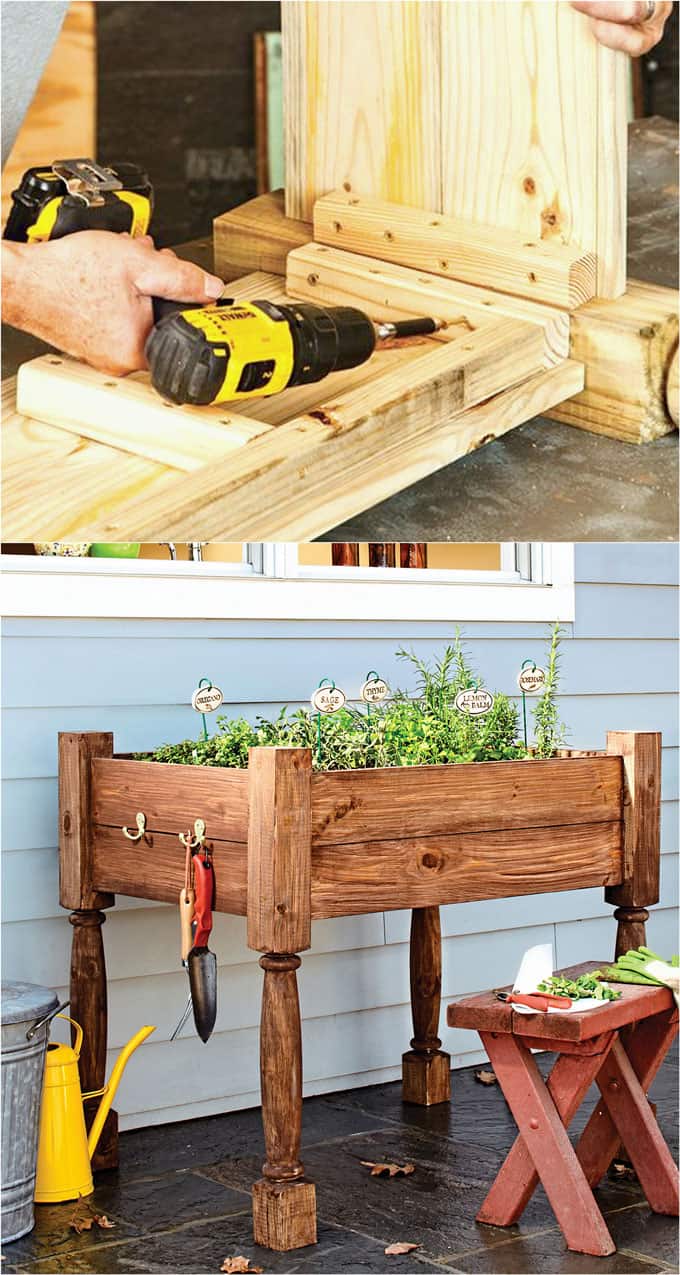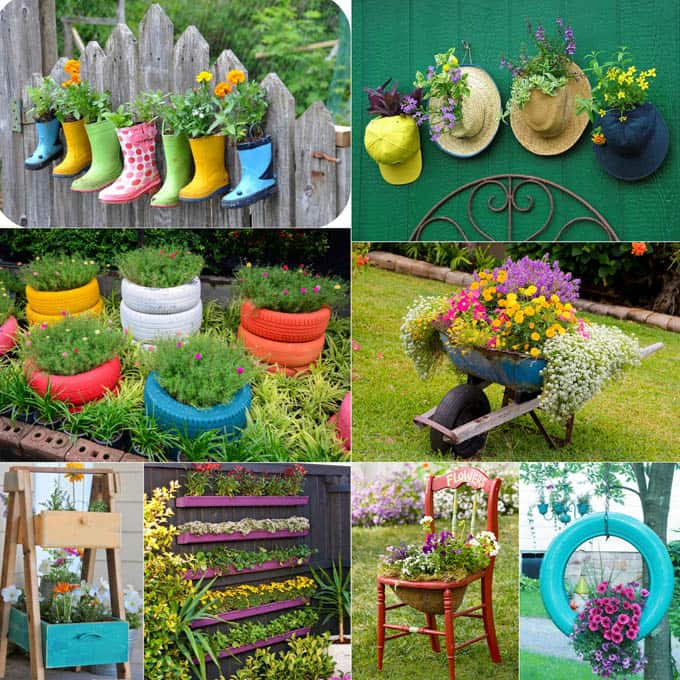All About DIY Raised Bed Gardens – Part 1
One of our most loved gardening methods is the raised bed.
Easy to build and cost effective, a raised bed garden can instantly turn a brown thumb to green, and a challenging site into an abundant garden with beautiful flowers and delicious veggies!

In Part 1 ( updated 2018) of the All About Raised Bed garden series, we will look at the following questions in detail:
- How deep should a raised vegetable garden be?
- Can a raised bed be built on grass or concrete?
- What kind of wood should be used for raised bed gardens?
- How to build a raised bed?
- What can I grow in a raised bed garden?
In part 2, we will explore many inspiring examples of DIY raised beds. Check out part 2 here.
*Some resources in article are affiliate links. Full disclosure here.
The great benefits of a raised bed garden.
Super Productive! Raised bed gardens minimize soil compaction and promotes healthy root growth. When you fill a raised bed with great soil, you will be amazed at how fast each plant grows! ( Image source )

Which leads to the most important tip on how to maximize the benefits of a raised bed: Soil is the key.
Filling a raised bed can take a ton of soil, literally. Look for bulk soil which you can mix with compost or horse manure. Contractors often have free soil from excavation which they give away on Craigslist. Just make sure it is uncontaminated!
You can also make your own compost for raised bed gardens! Start with readily available materials, and let nature do the work! Here are some of the best ways to make compost for your garden, and 35 great DIY compost bin ideas.

This method above is called lasagna gardening. There are some fabulous books on this topic, such as this one Lasagna Gardening: A New Layering System for Bountiful Gardens: No Digging, No Tilling, No Weeding, No Kidding! The title sums it all!
You can either fill a bed with good soil, or top off the “lasagna layers” with at least 6″ of good soil, both options will allow you to start planting right away.
We have tried many soils for containers and raised bed gardens, and we really like the Kellogg’s raised bed mix available at Home Depot, Lowes, and many nurseries. Kellogg is a great company with lots of fabulous soil products made from high quality organic ingredients. You can learn more about them here.

Once you fill the raised bed with soil or compost, top it off with 2-3 inches of good quality soil blend or organic compost each year to give it a boost.
Another great benefit of a raised bed garden is comfort.
Gardening is hard work. Build the garden bed to a seating height of 18″, or counter height of 36″ will make it so much easier for many people who have physical discomfort such as back pains.

Raised garden beds can become design elements that make a garden more beautiful and inviting. These beautiful examples of raised beds below can be great inspirations for our own DIY raised bed gardens!

How deep should a raised vegetable garden be?
A raised bed built on top of soil can be any depth starting at 4-6 inches. A raised bed built on hard surfaces such as concrete or asphalt, or on really rock sites should be 18 inches or more to encourage healthy root growth.

Can a raised bed be built on grass or concrete?
Many backyards are not ideal garden sites, some have weeds or grass, some have poor soil, pavers or concrete.
When building a raised bed on grass , the soil should be at least 12 inches deep so the grass won’t come up. Weed barrier landscape fabric is also a good way to suppress the grass growth underneath.

How to build a raised bed on concrete? No need to put wood on the bottom. You can put a raised bed directly on paving, but the following method is recommended: Start with 1-2″ of gravel to help with drainage, add a layer of weed barrier landscape fabric, along the sides and bottoms of the beds to keep the soil from running off. Then 18 inches or more of soil on top.
What kind of wood should be used for raised garden beds?
The key is to choose rot resistant wood such as Cedar, Redwood, or any local wood that has similar qualities, which can last 10 to 20 years. Certain types of pine can work, other types might be too soft. Talk to your local lumber yard.
2x6s are great for building raised bed. You can make the raised bed multi-tiered to raise the overall height of your raised garden beds.
Avoid pressure treated wood, as they may contain harmful chemicals. Some say they are safer now than before, but I personally would still go with un-treated rot resistant species of wood.
Sealers are not required. However if you do choose to use paints or sealers, choose non-toxic ones. ( source )

Gopher proof your garden.
This is a huge plus for us. We have so many gophers here in our garden, and gophers LOVE veggies.
We used metal stucco lath to line the bottom of our raised beds. You can also use galvanized hardware cloth like shown below from Foods for Long Life .

We stapled ours on the inside of the raised beds. Chicken wire does not work as well because the holes are a bit large, and they deteriorate more quickly.
Be careful when digging. If the wires are punctured, gophers will find their way in!
This happened to us. Our broccoli plants started disappearing one day, and we saw the little mounds of soil – criminal evidence! Luckily, it’s easy to trace a gopher tunnel. We found the punctured spot and blocked it with large rocks. No more damage after that!
How to build a raised bed?

What can I grow in a raised bed garden?
The answer is: every flower and vegetable you can imagine!

Larger vegetables and plants such as kale, broccoli, cauliflower, squash, tomatoes and sunflowers, etc will be more productive in a bed that is on top of soil, or deeper that 2 feet.
Smaller herbs, flowers and vegetables such as lettuce, chard, radish, beans, bok choy, etc can be quite productive in raised beds 1 to 2 feet deep. ( images: 1 | 2 | 3 )
If you love raised beds, you will love these 32 creative containers made from surprising materials!

And these 25 most beautiful DIY friendly garden paths-

Update: part 2 is here- 28 inspiring raised beds with tutorials!

Happy gardening! xo




That was really helpful! So many planter ideas.Thank you!
I like this POST.
Thanh for sharing!
Me encanta todo esta hermoso y fácil de usar hacer gracias
I LOVE this. I really want to put together some raised beds this year, but I’ve been concerned because I didn’t know how to cut the corners to fit together, but I’ve been thinking about it and they don’t really have to. I can just put them together like you’ve done here and make it really easy on myself lol!
Our land has absolutely terrible soil. I tried to have a garden for 5 years with no luck and finally started some rraised beds last year and I’m so much happier. This year I am going to finish the garden with all raised beds.
I love raised garden beds! We need to work on getting our garden set up this year and we really want to do a raised garden! I love the look of them and how beneficial they can be for what you’re growing.
These gardens are so beautiful!! My parents have several raised beds at their house, and they really enjoy them!
I think that raised flowerbeds are so pretty! We have very hard ground and the soikl isn’t great so this would be great.
Some of these raised beds are absolutely beautiful! I have one and for some reason the earwigs don’t seem to bother my plants there, but absolutely gobble up basil if I plant it elsewhere in the garden.
Thank you for such an informative post! I’ve been trying to garden more but can’t use the ground where we live, so I’m relying on potted plants to keep me sane. I think I might try this soon with a vegetable garden! Thanks again for the helpful tips! You’re amazing! 🙂
I love this idea. We’ve got 2 huge islands in our backyard and they are so difficult to maintain. I think well have to try this out.
This is such a great post! I miss having raised beds to plant in. Love the breakdown/photo of how to make great planting soil.
Handsomely! Tell me please, heavy rain erodes the soil inside the construction? Or mesh at the bottom keeps the soil?
not so much due to rain, but plants use up soil, so it needs to be replenished yearly! no need for mesh unless you have gophers, etc. =)
I LOVE this post. I’ve been wanting to put a raised bed in our backyard. Awesome photos too!
Oh my goodness!!!! I love these! I wish I had a yard big enough to have these. When I buy a home i’ll definitely be building one of these. Gotta pin this for later 🙂 Thanks for sharing!
Awesome work and post! Tis the season to garden
Raised beds are what we’re switching to this year. I worked my butt off creating a garden plot last year and it was nearly impossible to keep up with the ever returning weeds and even with lots of amendment, the soil was less than ideal. We had very little yield for the size of the garden.
I LOVE my raised bed and can’t imagine my life without it! Great post!
This is such a helpful post and I definitely will be building one of these now! Thanks for sharing 🙂
Thank you for this post. I’m planning on making some raised planters this weekend.
I love our raised beds! They keep the dogs and kids out of the garden, and they’re really easy to weed. I wish I had room for more of them.
Ooh I love how these look! I can’t wait till we have a backyard so we can put pretty flowers in our garden.
xoxo, Jenny
We are planning our first garden this year and are going to build some raised beds as well. Thank you so much for your tips. I really looking forward to the second part of your series.
I love this idea……